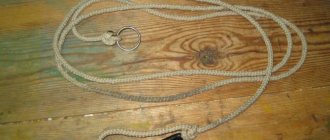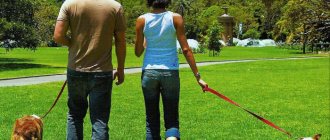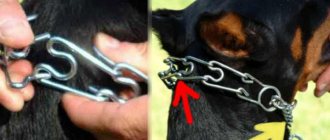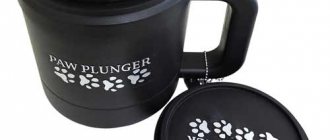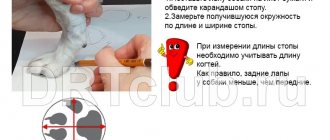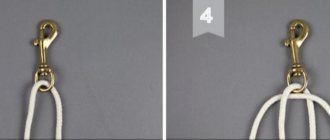Greetings to all do-it-yourselfers, as well as dog breeders!
Today I want to share an idea for making a very simple, homemade choke leash for training young dogs and puppies.
I think every dog owner knows that any dog (both large and small) must have certain training skills and obedience to the owner. Moreover, this does not mean at all that every dog needs to be intensively trained and undergo a GCD (general training course).
If the dog is not a service dog, but is kept in the family simply as a pet and friend, then the ability to walk on a leash and knowledge of at least two basic commands: “stay” and “come to me” is enough for it. This alone makes the dog manageable and obedient, and on occasion it can simply save its life, especially in the dangerous conditions of a big city.
At the same time, it is advisable to begin raising a dog from puppyhood. Well, in order to facilitate and speed up the upbringing and training of a dog, it is very good to use a special device in the form of a leash with a strict collar or a choke collar.
It must be said that there are now a huge number of different strict collars on sale. Moreover, the basis of all these collars is the property of tightening like a noose or noose with a sharp jerk, which naturally has a certain effect on the dog.
However, such collars are often quite expensive. But at the same time, there is no particular point in buying them, since such a collar is needed only for the period of raising and training the dog.
For example, I have long been convinced that in ordinary cases, for the successful training of a dog, a very easy-to-make, homemade noose leash is quite suitable. Such a leash can be easily made in a few minutes, and it will cost almost nothing. At the same time, it can last for a very long time and with its help, you can raise more than one generation of dogs.
I've been using a similar leash for many years now. This is what he looks like.
As you can see, it can be made from ordinary rope.
Purpose of the noose leash
All dogs are different, each has its own special character. There are large dogs that behave very excitedly during walks, chasing every cat, dog or even bird. In this case, it is usually incredibly difficult for the owner to keep a large dog on a leash. It is for such dogs that a noose leash is needed, with the help of which the dog can be stopped without much difficulty. Moreover, this dog training collar fits very well.
ATTENTION! After using the choke for some time, the dog usually gets used to normal behavior and then the choke can be replaced with a regular collar.
Detailed Specifications
Collars differ in the material they are made from.
Before purchasing an accessory, it is important to familiarize yourself with the different types and choose the most suitable one. They are made from the following materials:
- Nylon is the most durable dog collar, glides well, does not cling to rings, and can be used in any weather. The collar has a drawback: if pulled sharply, it can cause pain to the animal and cut the owner's hand.
- Leather - beautiful and comfortable, suitable for short-haired breeds. Without proper care, the collar quickly loses its attractive appearance.
- Metal - when used, it can harm the coat, so it is intended for dogs with short hair.
Important! A dog leash with a lock, made of combined materials, is also used for training. The collar can harm the animal
The collar can harm the animal
Advantages and disadvantages
The noose leash has positive and negative sides. The advantages include:
- success in training;
- low price;
- ease of use.
Cons of a choke collar for dogs:
- with constant wear, it cripples the dog’s psyche;
- can damage the hair and cause harm to the pet;
- A nylon leash can cause injury to the owner or the dog.
Features of leash training for an adult dog
The stages of training an adult animal differ from those described earlier. If a dog has spent a long time in an enclosure or a kennel cage, its training begins with a leash about 8 meters long. Work with the dog in an open area, the leash should hang freely. The leash is shortened gradually as you get used to it. Usually an adult animal does not want to walk on a short leash. Treats are used for training. When luring the dog with a tasty morsel, they make sure that it does not run ahead and block the owner’s path.
One lesson with an adult dog should not exceed half an hour in duration.
Leash training an adult dog requires patience from the owner.
Training a puppy using a choke collar
For some puppies, using a choke collar is a must. Still untrained puppies are distracted with the help of a noose from various external factors that interfere with training. If the noose is used wisely, it does not cause any harm to the dog, but it helps the owner cope with the still uncontrollable dog. When the dog jerks, the amount of incoming air decreases and this immediately moderates the ardor of a temperamental dog.
The noose itself looks like a regular collar, but it does not have a standard clasp. Instead there are restrictive rings. When putting the collar on the dog, it is passed through one ring and the loop is placed around the pet's neck. A leash is attached to the other ring. When it is not pulled, the collar is completely loose around the neck. As soon as the dog jerks, the leash tightens and the choke tightens, causing the dog to experience discomfort.
REFERENCE! There is also a noose collar with a lock or with three rings on sale. Their action is the same, only the third ring limits the size to which the collar can be tightened. Even with this diameter it will no longer tighten and certainly will not choke the dog.
Use for behavior correction and training
A dog training noose is an indispensable accessory for the owner. Because with its help you can achieve obedience in a short time. If used correctly, the collar will not harm the dog.
It is necessary to accustom oneself to such a collar from puppyhood, since an adult dog has already formed its character, and the dog can react to the noose aggressively or passively. In case of aggression, the dog is calmed down, distracted from the leash by loosening the tension. After the pet has completely calmed down, you can gradually begin studying. Over time, the pet will form a reflex, and it will stop pulling in different directions.
With a passive reaction, the dog lies down and does not pay attention to the owner’s commands. In this case, dog handlers recommend making a slight jerk and rewarding him at the slightest activity. After some time, the animal will understand that the noose will not harm it and will unquestioningly carry out its tasks.
Important! A collar can cause serious stress.
A noose is a reliable assistant during training
Training a dog with a choke collar
This collar is intended for training purposes only. It is better to carry it out in a deserted place so that no one distracts the animal.
Actions during classes:
- The pet is placed at the left leg.
- Next, the owner begins to move slowly. In this case, the dog should walk alongside, and the leash should be loosened and slightly sagging.
- If the dog makes a jerk to the side, you need to stop. When stopping, the noose tightens, creating discomfort for her.
- After the dog returns to its original place, the movement continues. The owner must make it clear to him that he must walk clearly with his left foot. If the dog does everything correctly, he needs to be praised.
Experts recommend using a noose only during exercise, and putting your pet on an ordinary collar while walking. This is explained by:
- during play, it may slip off the neck;
- when running, it can get caught on something and cause injury to the animal;
- With constant use of a noose, the dog’s conditioned reflex disappears and it stops responding to the discomfort caused.
During games, the noose is removed
Usage
The choke collar is used for training dogs from 5 months. It is unacceptable to use on puppies and is not recommended for use on small breed dogs, as there is a high risk of injury to the cervical spine and suffocation.
The accessory is placed around the neck and a leash is attached to the end through which the noose does not slip. The collar should not put pressure on the neck, so it should be worn so that two fingers folded together can be inserted between it and the neck. A collar that is too tight will cause breathing problems. If everything is done correctly, then when tensioned, the loop will tighten, and after reducing the tension, the loop will loosen.
Choke collars are not intended for everyday use; they are worn only during training and training. Many dog owners purposefully buy nooses for daily walks, considering them convenient, because they hang freely and do not spoil the hair, and do not cause inconvenience to the dog if it does not pull the leash. Such use is unacceptable, because there are other types of collars for such purposes.
During the training process, you should not pull the noose. You need to show the dog that it is not he who gives the direction. The trainer, holding the leash closer to the base, walks at a normal pace, abruptly changing direction, thereby tightening the leash, the dog experiences unpleasant sensations, the trainer loosens the leash and rewards the animal with a treat, stroking or words. You should not leave an animal in a choke collar unattended. As you watch the video, notice that the trainer does not jerk the leash sharply.
Purpose of a strict collar
Owners often use parfors on an ongoing basis. In fact, the purpose of a strict collar is to correct behavior. In recent years, the use of parfors has been frowned upon because studies have shown the health hazards caused by the thorns squeezing the neck.
This is interesting! One of the arguments for using parfors is the imitation of a mother's grip on the neck.
If you're inclined to buy parforce just because “everyone else is doing it,” take a little time to explore alternatives. To train a dog, you can use a sliding noose, a halter, or, in extreme cases, a jerk chain . With the right approach, dogs can successfully train in regular, wide collars. Nozzles of various types are used only to eliminate negative habits.
Material of manufacture
There is a large selection of choke collars with three or two rings for dogs on sale. The material from which they are made can be leather or its substitute, metal chains, links or nylon cord. When choosing a choke for each dog, you need to study all the pros and cons of the material from which it is made.
Let's look at the collar options:
- Nylon noose It is considered the most durable collar, as it glides well without clinging to the ring. You can wear such a collar in any weather and you can even swim with it in the sea or other body of water.
The downside of a nylon collar is the possibility of causing pain to the dog and also cutting the owner’s hands.
- Leather collars for dogs are considered the most beautiful and pleasant for the owner. Leather harnesses are suitable for dogs with short hair and are very comfortable for them. The disadvantage of a leather collar is that it requires special care, or it will quickly lose its attractiveness.
3. Metal can stain dog hair where they come into contact. In addition, wool can get into the joints of the metal chain links. For these reasons, metal chokes are not used on dogs with long, light hair. They are used mainly for smooth-haired dogs. These collars look very beautiful and are used mainly during exhibitions to decorate pets.
NOTE! There are also combination collars made from nylon cord to increase durability, with the addition of nice leather.
What does parfors look like and what is it made from?
First, let's figure out what parfors looks like and what it is made of. A strict collar is one of the models of the so-called nooses (chokes). All collars of this type tighten when the dog pulls on the leash. The direct purpose of the parfors is temporary wearing during training.
Parfors consists of links. The number of links is selected based on the maximum jerk force. All parfors links are detachable, that is, the collar can be made looser or tighter.
Parfors are made of metal. Two popular options are nickel-plated steel or stainless steel. The second option is more expensive and safer. Coated collars are susceptible to moisture and their links bend more easily.
What is a dog show ring?
To obtain the coveted victory at the exhibition, the correct choice of show ring plays an important role. And also important is the handler’s ability to control this accessory.
A ring leash on a dog. Such leashes are present in the list of products of almost every manufacturer of pet products; there are a very large number of them on sale.
Materials and design
Rings are made from different materials. The most popular are leather or nylon leashes . You need to fasten the leash behind the pet's ears, or open it wide and lie on the animal's back, on the chest, passing through the shoulder blades.
At their core, rings are a device in between a collar, a noose and a leash. They are manufactured in a wide variety of designs. There is also a fashion for the advantages of their appearance, color scheme and material. But the right to choose it always remains with the pet owner, regardless of fashion trends.
The ringovka is made from different materials.
Gallery of show rings
A show leash is a show leash.
You need to know how to use it.
There are a large number of varieties.
The leash is attached to the ears.
The ring is not noticeable on the dog.
You should select according to the color of the dog's coat.
Leash-noose at home
You can make a pretty decent dog collar with your own hands. To do this, you need approximately 4 meters of nylon cord, 3 metal rings, glue, strong synthetic thread and heat shrink tubing.
In order to make a collar, you need to thread a nylon cord through the ring and make a pigtail of the required length, leaving a reserve. You can calculate the required length of the noose by measuring the circumference of the dog's neck and subtracting the diameter of the ring from there. When braiding a braid, you need to weave a ring that will act as a retainer. At the end of the braid, it needs to be threaded into the second ring and bent. Then the bent ends need to be scorched over the flame, connecting them behind the ring.
To make the collar more durable, the joint must be tied with thread and glued with universal glue. The ring that acts as a limiter also needs to be secured with thread and glue. If it doesn’t turn out very neatly and beautifully, you can cover the joint with heat-shrink tubing. Well, the noose is ready for your dog.
Wicker options
You can weave a dog collar from a number of available materials. For this you can use:
- Fabric scraps;
- Old belts;
- Clothesline or nylon rope.
In addition to the above, you will need to take care of the clasp. This can be a flexiblex or a noose-type mechanism or a semi-noose type mechanism. For a noose, 2 identical metal rings are required, for a semi noose, 3 rings and a chain.
Note!
Cake decorating: TOP-170 photos of the best ideas for decorating a cake at home + instructions for beginners with simple patterns
How to make a house out of cardboard: 140 best photos of children's crafts with your own hands + step-by-step manufacturing instructions with simple diagrams
DIY rose lamp - step-by-step instructions for creating a lamp with your own hands + original design ideas with photo reviews
Do-it-yourself martingale collar
If the noose is too much for you, then we suggest making a half noose.
You will need:
- Raincoat
- Izolon or polyethylene foam
- Metal rings (can be D-shaped)
- Sling
- Optional, ribbon (for finishing)
We calculate the length of the collar - this is the circumference of the neck, minus the diameter of the ring. Add five to seven millimeters to the width of the sling and get the width of the collar.
We cut out a rectangle of the required size from the isolon, lay it on the raincoat fabric, add two centimeters to all sides, and cut it out again.
We cover the isolon with raincoat fabric.
We measure the sling 30 centimeters longer than the neck in circumference in order to firmly secure the rings.
Actually, we attach the sling to the collar blank, thread it through the rings and firmly sew the ends with a triple stitch on the machine.
Important! From one end we release the required length of the sling, pass this end through the second ring, then attach it to the side of the collar from which it comes. This is our control circuit.
The second ring can be secured in the middle of the control outline by stitching it with a cross stitch.
We remove the threads that were used to sweep away the sling with the workpiece and our martingale is ready.
Before using such collars, be sure to consult with a competent dog handler . He will give you detailed instructions and recommendations.
Taking measurements from your pet
To determine the length of the sling, taking into account all the necessary fastenings, first of all, we need to measure the circumference of the pet’s neck. If you don't have a soft sewing meter at hand, you can use any ribbon and then measure it with a regular ruler. Or just use the old collar as a guide.
You have measured the circumference of your dog's neck. We multiply the resulting value by 1.7.
That is, if your dog has a neck girth of 30 cm, multiply this figure by 1.7. It turns out that you will need a sling 51cm long. This will be the length of the main large outline.
For a small control circuit, the line should be slightly shorter. This length does not depend on what size your furry friend is. A sling length of 30-35cm will be sufficient.
The small contour only allows you to freely put the collar over your head, and then evenly distribute the load when the dog tightens and loosens the leash.
You don't have to worry that the collar will be too small or too big. To adjust the desired girth, we will later make an additional buckle on the main contour.
But you need to decide in advance on the width of the sling. The choice of sling width directly depends on the size, breed and age of your furry friend. If you have a large breed dog, then the sling should be wider and the fittings stronger.
For my Jack, I took fittings and a 2.5 cm wide sling. By the way, the size of all accessories is selected based on the width of the sling, and is measured by the width of the holes into which the sling will be threaded.
Possible errors and problems
When training, mistakes are possible, the admission of which complicates training or makes it incorrect.
- Jerk before the command is given. He knocks the dog down and doesn’t make it clear what they want from him.
- Driving a dog on a tight leash. Execution of the “nearby” command must be carried out on a loose leash, and subsequently without it, otherwise the dog will get used to the constant feeling of tension on the collar and will begin to consider this the norm.
- Giving a command with different intonation. The dog will not be able to remember all your intonations and associate them with a specific command, and a rude tone may even frighten him.
- Repeating the command when the dog walks nearby. If the dog follows a command, it should not be repeated again. This way, the pet can associate repeated issuance of a command with the norm and will carry it out only on a double command.
- The position of the dog when walking side by side is half a length forward/backward. This position of the dog makes it difficult for him to give other commands with a gesture, and also slows down the pet’s reaction to changing traffic conditions.
- Parallel study of different commands. It is difficult for an animal to learn several commands at once; it is worth practicing them one by one.
- Punishment for failure to follow commands. When teaching a dog commands, it is strictly not recommended to raise your voice or physically punish it. In this case, your pet’s training will be associated with negative emotions and will become ineffective.
Photo: Scott 97006
Photo: Virginia State Parks
Raising a dog is a labor-intensive process that requires patience and time, but the result can not only ensure its safety and save you stress, but also make your pet a well-deserved source of pride.
How to teach a dog to walk next to you without a leash
You should start learning to walk side by side without a leash only when the dog has learned to confidently walk side by side on a leash, without straining it and maintaining the required position.
To practice walking side by side without a leash, make the leash longer and give a command when the pet walks on a loose leash.
Gradually increase the distance; when the distance exceeds 5 meters, call the dog with the command “come to me”, and only then give the command “near”. And don’t forget to reward with praise, affection or treats.
Photo: Scoutdogs (Chris)
When your pet masters the “near” command from a distance of 5 meters, you can begin practicing the command at a distance when the dog walks without a leash.
However, remember that mastering walking side by side without a leash does not mean that you can eliminate walking on a leash - the dog may gradually become spoiled and stop maintaining the distance and the necessary position in space.
conclusions
It is worth remembering that the beauty of this accessory is certainly important, but its purpose is to restrain the dog. Therefore, pay more attention to the strength of materials and the quality of stitching. After all, an animal with a sudden movement can damage them and escape from your hands. If you doubt that the ring you made yourself will not be able to withstand the impulse of your pet, then purchase a leash in the store.
Show rings for dogs must be made of durable material.
How to teach a dog to walk next to you without a leash
You can accustom your dog to the “Near” command without a leash no earlier than at the age of 6 months, and the pet must move well “near” on a leash.
Take a longer leash and first act in the same way as in the first stage
- give the command when the dog is walking on a completely loose leash. However, gradually increase the distance from which the command is given (if the dog is further than 5 meters from you, then first you need to give the command “Come to me”, and only then “Near”).
When the dog has learned to carry out a command from a distance of 4-5 meters, try to command when it is walking without a leash
. Remember: in order for your pet to perfectly follow commands without a leash, he must regularly walk “side by side” on a leash. If you are lazy and force your dog to walk “side by side” only without a leash, then in a week it will stop obeying.
Training conditions
You should start training a dog only if it is in normal physical condition (not sick, not depressed and does not refuse food). It is better to feed the dog a couple of hours before, and take it for a walk just before practicing the commands, so that it does all the necessary things and slightly wastes energy, which will prevent absent-minded attention.
You should choose a secluded area for training - at the beginning of training, you do not want unnecessary noise and the presence of strangers, which the dog can be distracted by. It is better if it is a fairly spacious area in the fresh air that is familiar to the dog, with an even surface.
At first, it is better to avoid noisy places. Photo: Kate Hart
When the dog begins to make progress in mastering the command, you should slightly add distractions - change the training location or invite spectators. However, if the dog is very distracted, it is too early to leave the secluded training area.
What you need for training
To teach the “near” command, you will need a collar, a leash, treats for reward, and your favorite toy will also come in handy.
Training should be done daily for 15 minutes. If the dog is tired or distracted, it is best to stop training and continue the next day.
Which delicacy to choose
Treats for reward during training should be in the form of small pieces, not crumble and not get your hands dirty. You can only choose the most suitable treat for your dog through experience. These can be pieces of chicken, sausages, vegetables, fruits, cheese, dry food, and store-bought treats.
Industrially made treats for dogs
Some dogs willingly work for pieces of biscuits. The treat needs to be chosen so that it is desirable for your dog. It is better to choose several types of treats and alternate them periodically so that the dog does not get bored with them.
When to use a special collar
It is not always possible to teach a dog commands using ordinary techniques and equipment. If the dog is a fairly large breed, disobedient, hyperactive or aggressive, then a special collar can help you: a choke collar, a strict collar or an electronic collar.
All this ammunition requires knowledge of its practical use and special care in use.
How to tie a scaffold knot
This article will list all possible self-tightening loops that can be used for bondage and selfbondage. Running simple knot
Knitted in 3 movements, it is one of the simplest self-tightening knots. When pulling at the end, the loop is tightened; in order to increase the loop, when it is not yet very tight, you need to pull the loop in the opposite direction.
Sliding eight
Knitting this loop is not difficult at all, so you shouldn't have any problems with it. In general, such a knot is usually used when tying bags or the like, but we can use it, for example, to tie legs or arms.
Sliding blind loop
It is also knitted in 3 stages, first we fold the rope in half, then, as shown in the picture, we pass the ends into a loop and then tighten it. You can use this knot as a noose for rope handcuffs.
Running bowline
Knot of medium complexity. It is based on the lasso principle. Often used in maritime affairs, for catching logs and anchors.
Silk knot
The snare knot is used by bird catchers. The knot is considered one of the smoothest and easiest knots to tighten.
Scaffold node
The name of this node speaks for itself. It was used in ancient times for hanging, but we can use it for our binding works.
Tightening noose
Like the previous knot, it is called a scaffold or gallows knot. As you already understood, it was used for hanging.
To tie this knot, the cable is laid in the form of two loops of equal size. Both loops are surrounded several times with the running end of the cable, after which this end is passed into the loop facing the root part of the cable and, pulling out the outer loop, is clamped in it. A tightening noose can always be easily untied by pulling the main part of the cable.
Drunk and shackled
Drunk on the left and shackled on the right.
These two knots are almost similar; when you tie them, you get 2 tightening loops or, more simply, self-tightening handcuffs.
1 review to “Tightening loops”
MAGICALLY. WHAT KIND OF ROPE DO YOU NEED? THE LINEN IS OBVIOUSLY TOO THIN, IT WILL CUT YOUR HANDS AND LEGS.
Sea knots. Tightening loops
In the picture: a running simple knot.
RUNNING SIMPLE NODE. The simplest knot that forms a tightening loop. When pulling on the root end, the loop is tightened, but it can be increased in size by pulling the running end away from the loop. The knot can be tied in any part of the rope. With its help, you can attach a cable to something and moor the boat by a pile.
In the picture: sliding figure eight.
SLIDING “FIG EIGHT”. Based on the figure-of-eight principle, this knot belongs to the category of reliable, tightly tightened loops. It has the property of being tightened smoothly and evenly when pulled at the root end.
In the picture: a sliding blind loop.
SLIDING BIND LOOP. Tying a knot is extremely simple and does not require any explanation.
In the picture: a running bowline.
RUNNING BOWLINE. The same arbor knot with a small loop into which the root end is passed. Based on the lasso principle, it works flawlessly. In maritime practice, they are used to search for and lift Admiralty anchors left at the bottom.
In the picture: a power unit.
POWER KNOT. Borrowed from the simple technique of bird catchers. It is considered one of the most smoothly and easily tightened knots.
In the picture: scaffold assembly.
SCAFFOLD UNIT. Its name speaks volumes about its purpose. One of the ancient knots, developed by the centuries-old practice of the death penalty by hanging. But it can be successfully used for many other purposes. For example, for temporarily attaching a cable to various objects.
In the picture: a tightening noose.
PROTRACTING NOZZLE. Like the previous one, this knot is called the “scaffold” or “hanging” knot. But, despite this, it also finds its application in maritime affairs. It is used when temporarily securing a cable to objects floating in the water or when throwing and securing a cable to an object on the shore.
This knot has an advantage even over such a good knot as a noose with half bayonets; in it, the running end of the cable cannot be whipped out of the loop, and therefore a tightening noose is considered more reliable. On sailing ships, this knot was used to fasten the main ends of topsail sheets, topsail sheets and other gear in cases where it was necessary to have these ends ready for release.
To tie this knot, the cable is laid in the form of two loops of equal size. Both loops are surrounded several times with the running end of the cable, then this end is passed into the loop facing the root part of the cable and, pulling out the outer loop, is clamped in it. A tightening noose can always be easily untied by pulling the main part of the cable.
This node can be used in two ways. Firstly, according to its knitting pattern, it is convenient to store the cable in the form of a compact coil. By tying this knot without a loop at the running end of the throwing end, we get excellent ease. If it does not seem heavy enough, you should lower it into water before use.
DRUNK KNOT. This section of knots contains knots with two tightening loops. When the running and main ends are pulled simultaneously, the loops are tightened. From time immemorial, this knot was called a drunken knot, apparently it was used to pacify excessively riotous sailors, putting loops on the wrists behind their backs, and tying the ends on the chest.
In the picture: shackle knot.
SHANDEL KNOT. Very similar to a drunken knot. Its name in English means “handcuffs”. Can serve the same purpose as a drunken knot. But despite the external similarity, these are two different nodes. In any case, without untying them and without removing the ends from the central loop, it is impossible to turn one knot into another. Some sailors call this knot a “double masthead knot” because it is sometimes used in a similar way to the masthead knot.
Source
Does training success depend on the dog's breed?
As a rule, all dogs are trainable, regardless of breed and size; differences can only be in the speed of mastering the command. Some breeds (retrievers, poodles, German shepherds, papillons, shelties, Dobermans and Rottweilers) learn faster, some (chow-chows, bulldogs, Afghan hounds) take longer, but it all depends on the owner, his readiness and efforts in training the pet.
Also, the speed of learning can be affected by the characteristics of the pet - dogs with high activity are less able to keep their attention on the task at hand.
